Moonshine Sansevierias or Moonshine Snake Plants are beautiful indoor plants. They enhance your home’s appearance and clean the air around it. If this is the first time you have heard about this plant, it might be intimidating to care for, but you’re in excellent hands! Everything you need to know about maintaining a Moonshine Snake Plant care is provided here.
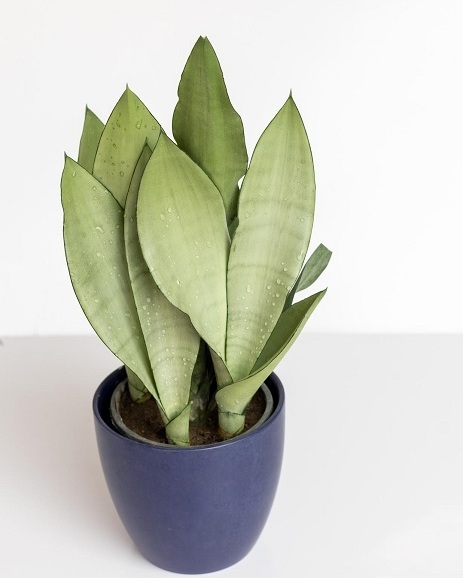
For Moonshine Snake Plants to grow, indirect sunlight must be abundant. Always make careful to allow your plant totally dry out in between waterings since they are susceptible to rot problems. Despite being resilient, these plants favor warmer climates. To avoid illness, it’s crucial to keep the leaves dry.
This article will guide you in caring for this gorgeous Snake Plant. Surely, you will be well on your way to a fruitful relationship with your plant after you have a few easy tips and tactics under your belt.
Moonshine Snake Plant Profile
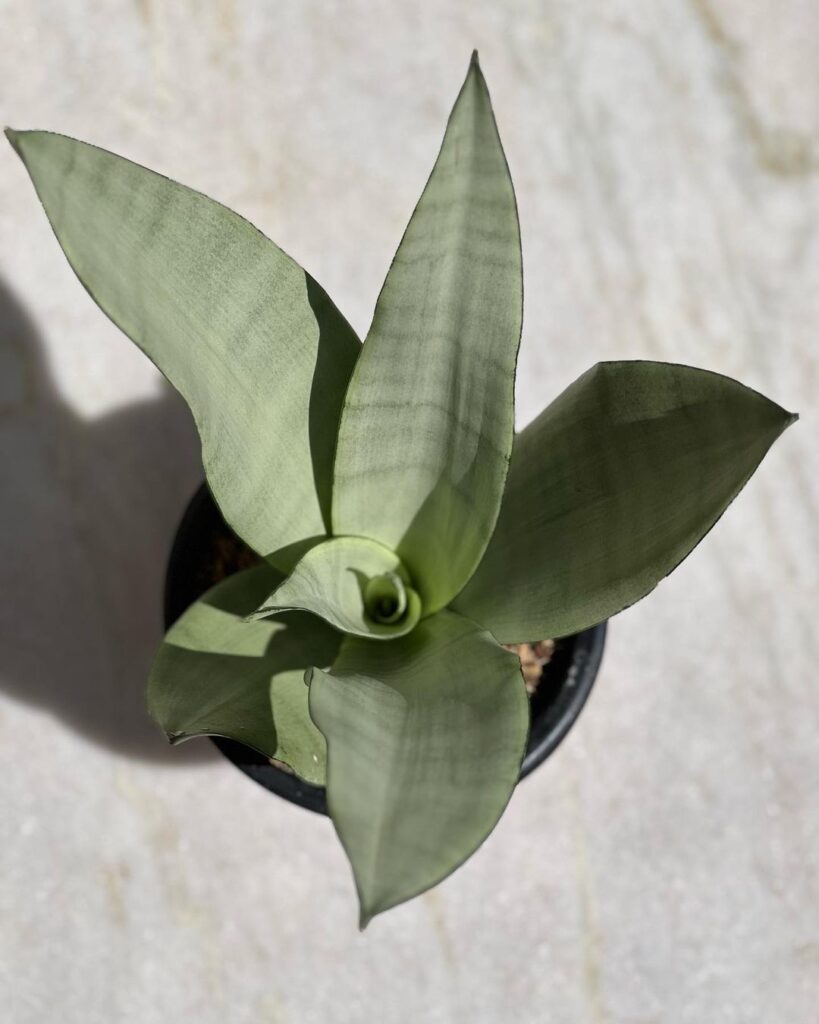
General Information
These resilient plants are a variety of the Asparagaceae family’s Sansevieria trifasciata cultivar. This stunning tropical plant is also known as the Silver Moonshine, Moonglow or Moonlight snake plant.
The Sansevieria trifasciata moonshine is a difficult-to-find plant that is native to the Congo and Nigeria. It’s a succulent that may grow quickly both inside and outdoors.
The unusual silvery leaves are large and have a thin, dark green border that runs down the margins. With white-silver tones, the more recent foliage stands out more. The color of the leaves darkens over time.
But exposure to inadequate light may lead to a deeper hue. The most important thing to keep in mind is that the color is not reversible if your plant is exposed to low light levels.
Etymology
The genus name Sansevieria was given in honor of the Italian scientist and inventor Raimondo di Sangro, Prince of San Severo. Vincenzo Petagna gave the genus its original name, Sanseverinia, in honor of his patron Pietro Antonio Sanseverino, Count of Chiaromonte, in whose Petagna garden had seen the plant.
More so, the common name of this plant refers to its green leaves. They resemble moonlight and are upright and broad in form, with a silvery-green hue.
Flowering
Although they are seldom seen in cultivation, flowers that do occur are typically green-white in color and beautifully perfumed. They may bloom in the summer or the fall.
Season Of Interest And Purchasing
Due to its scarcity, this plant is beloved and prized by collectors. If you ever have this plant, spring is the optimum time to reproduce it, as that is when the parent plant reaches its full, mature size.
In addition, the optimum time to buy it is from early spring to late summer, which is also the period of active growth.
Growth
Sansevieria Moonshine plants may reach heights of two to six feet (0.6m to 2m). The leaves of this plant grow vertically and may be up to four or five inches wide (10.2 to 12.7cm).
Both indoor and outdoor cultivation of the Silver Moonshine is possible. This unusual shrub is prized for its stunning silvery leaves. On rare occasions, the Silver Moonshine’s large leaves will have narrow, dark-green borders.
More pronounced white and silver tones may be seen in younger leaves. With time, the leaves darken, sometimes even turning a deeper green. Therefore, low light exposure may also cause the color of this plant to darken. Low illumination, however, has no adverse effects on the health of your Sansevieria moonshine.
Your plant’s leaves cannot be turned back to the previous color after they have changed to a deeper shade of green.
RELATED: Snake Plant Leaf Curling: Main Reasons Why It Happens and Solutions
Moonshine Snake Plant Overview
| Scientific name | Dracaena trifasciata ‘Moonshine’ |
| Common names | Moonshine Snake Plant, Moonshine Dracaena, Sansevieria Moonshine, Silver Moonshine, Moonglow Snake Plant |
| Family | Dracaenaceae |
| Growth Habit | Succulent Shrub |
| Height And Spread | up to 6 feet in height, and 1 foot in width |
| Classification Based On Life Cycle | Perennial |
| Origin And Distribution | Native to Congo and Nigeria |
| Climate Zone | Generally mild climate |
| USDA Plant Hardiness Zone | USDA Zone 10-12 |
| Color | Silvery white to dark geen leaves |
Care Tips
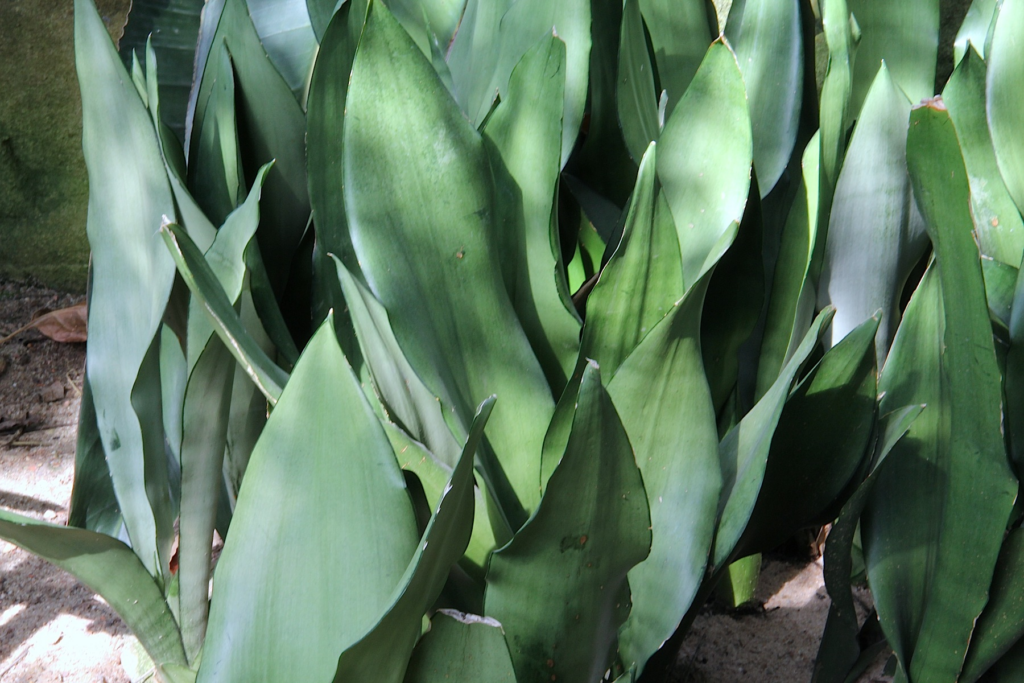
Light Requirement
The easygoing Silver Moonshine is not picky about lighting conditions, like other Sansevieria. It can adapt to any environment, including full sun, complete shade, and low light. However, your plant can start to display indications of sun blistering and leaf burn if exposed to bright, direct light for a very long time. On the other hand, lower light levels may cause moonshine plants to have darker green leaves.
Silver Moonshines should ideally be stored in a bright, indirect light. The perfect lighting arrangement helps the plant to get the nutrients it requires. As a result, the Sansevieria Moonshine flourishes best in this lighting condition.
You may also shift your Silver Moonshine from one kind of light condition to another. It just needs time to adjust to the new environment. To do this, gradually introduce the new light conditions to your plant. For a period of time, keep your Sansevieria moonshine in the new lighting environment. Then, increase the exposure period gradually until the plant has adjusted.
Read more about the light requirements of Snake Plants.
Temperature Requirement
The recommended temperature range for Sansevieria Moonshine is between 55°F and 85°F, which is 13°C and 29°C.
This plant enjoys warmer climates the most! The Silver Moonshine can withstand temperature variations, but not below 41°F (5°C). Your plant will begin to suffer if the temperature is lower than this level The leaves may sustain scarring if you leave your Snake Plant outdoors during winter season.
Water Requirement
Once the soil has dried up, water Sansevieria Moonshine every four to six weeks. Your plant doesn’t need to be watered heavily or frequently since it is drought-tolerant. The Silver Moonshine needs relatively little water to be robust, healthy, and successful.
The Sansevieria Moonshine is a succulent that retains water in its leaves. In fact, overwatering your Silver Moonshine is a major violation. Your lovely Silver Moonshine plant may eventually die from root rot if you overwater it.
Watering should take place once every two weeks throughout the Sansevieria Moonshine’s active growth season. However, the warmer months of spring and summer are when this plant is in its growth season. Therefore, the frequency of watering should be reduced to simply once a month in the winter.
The plant enters a dormant condition during the colder winter months, during which it stops consuming nutrients and absorbing water. Your Silver Moonshine plant’s roots will rot if you let it stay in water for too long.
You should only add a small amount of water to your Sansevieria Moonshine. The ideal amount of moisture for the soil is just enough to keep it moist but not waterlogged. You should wait until the earth is totally dry before giving your plant another watering.
The amount of water should be decreased even further if your Silver Moonshine is in a soil container that needs more drainage.
Access more information on Snake Plant water requirements.
Humidity Requirement
The Ideal room humidity level of Moonshine Snake Plant ranges from 40 to 50 percent. Therefore, no extra humidity is needed for the Sansevieria Moonshine. Extra humidity is not required since the soil requires time to dry out between waterings. Even the normal room humidity is enough for these plants.
Whatever the room’s relative humidity is, Silver Moonshine plants will thrive there. This plant is resilient and versatile, and it will easily fit into its environment.
Soil Requirement
The ideal soil mixture for Moonshine Snake Plant includes free-draining potting mixes such as those for succulents and cacti mix.
The Sansevieria Moonshine can withstand drought since it is a succulent. However, this indicates that it detests damp ground. Therefore, when selecting soil for your Silver Moonshine, drainage is a crucial consideration.
Additionally, potting mixes made without soil are also good for these plants because the organic material employed retains less moisture.
Root rot is a problem for this plant. Root rot is likely to be promoted by soil that takes longer to drain water. A healthier Sansevieria moonshine is the consequence of improved soil drainage.
Get more important information about soil requirements of Sansevierias.
Fertilizer Requirement
The Silver Moonshine grows slowly. Hence, fertilization should be done during the summer and spring growth seasons. You only need to fertilize your plant a maximum of twice a year. When doing this, fertilizers made for different types of cacti and succulents will be effective.
Avoid feeding your Sansevieria Moonshine too much. Remember that winter is not the time to fertilize your plant.
Space Requirement
The Moonshine Snake Plant is a lovely and interesting plant, although it isn’t particularly big. There are several sizes of Sansevierias, but this one can fit and grow in a little space.
RELATED: Snake Plant Brown Spots: Top Causes and How To Fix Them
Growing And Planting Tips
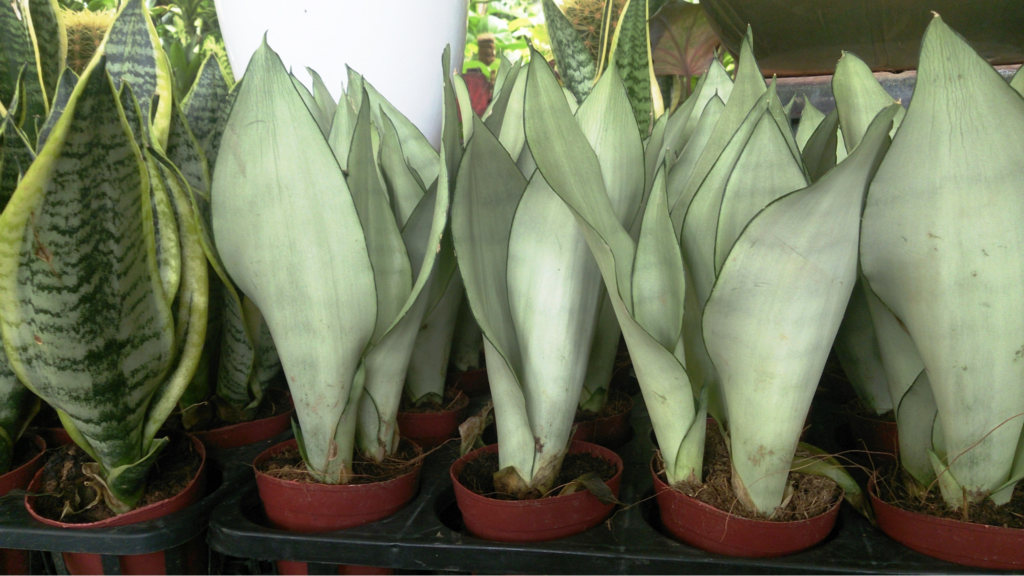
Propagation
You may propagate your Silver Moonshine by division, leaf cuttings, or offsets from the mother plant. However, the division method is the easiest among them.
Propagation Via Division
You can separate your plant’s overloaded leaf clusters after it has reached full maturity. The rootstock should then be detached from the leaf clusters. The clusters typically separate while parts of the roots are still in place.
Then, each of them may be put into a potting mix with good drainage. Your Silver Moonshine’s roots will last longer if the soil surrounding them is kept moist.
Propagation Via Offsets
New rhizomes are another name for offsets. All that has to be done to use this as a propagation technique is to detach the baby plant from the parent plant. Remember to take a healthy Sansevieria Moonshine leaf along with it.
The young plant can then be simply placed in well-draining soil. The offsets should not be watered right away. Before providing the Silver Moonshine offsets with further water, let the soil around them dry up for approximately a week.
Propagation Via Leaf Cuttings
Leaf cutting can be used for propagation. Cut the mature leaf into pieces that are at least 2 inches long (5cm). The Sansevieria Moonshine leaf’s clipped edge should then be allowed to dry and callus. This may need one or two days.
The leaf-cutting can be planted about an inch deep once it has scabbed over (2.5cm). Use soil that drains effectively. The cuttings will eventually start to develop their own roots.
Your new plants should always be put in an area with direct, strong light.
Pruning
Your Moonshine Snake Plant doesn’t require frequent pruning. However, if you want to change the height of your plant or get rid of a damaged leaf, this might be a terrific option. In any case, you should clip the problematic leaf as near to the earth as you can.
If the height of your plant is becoming an issue, remove the highest leaves by pruning them at the base. This will reduce the plant’s height and give you the desired effect.
Your plant’s health will increase if you remove any unhealthy leaves (browning, droopy, etc.). As soon as you see broken leaves, you should remove them to prevent the plant from squandering nutrients.
The procedure is same. To remove the damaged leaf, cut it with a clean blade close to the soil line.
Potting And Repotting
Moonshine Snake Plants grow in a setting that is relatively confined to pots. It is, therefore, ideal to repot them every 2 to 6 years, depending on the particular plant.
The plant will frequently literally burst out of its present pot, letting you know it’s time to repot. Your plant is informing you that it needs more room (obviously). Check your plant every three to four years if you don’t want to wait for a broken pot. Move the plant if the roots appear to be too crowded.
You carefully take the plant out of its pot to repot it. Add extra potting soil and repot the plant in a bigger container. Since your plant needs time to rest during the cooler months, it is advisable to do this during the warmer seasons. This might send the plant into stress and result in other problems.
Know more about proper potting and repotting of Snake Plants.
Moonshine Snake Plant Care
| Light | Bright indirect light |
| Temperature | Intermediate to warm, 55-85 degrees Fahrenheit |
| Water | Once a week, increased in summer, decreased in winter |
| Soil | Airy, well-draining soil; not too loose |
| Fertilization | Regular household fertilizer, once a month |
| Space | Substantial amount of space to spread |
| Propagation | Via division, offset, and leaf cuttings |
| Blooming | Rarely blooms, enough sunlight and maturity needed |
| Pruning | Not required |
| Potting | Regular potting mix, cactus and succulent mix |
Problems And Troubleshooting

Overwatering
Overwatering is the most common reason for this plant’s demise. Yellow leaves, stunted growth, and drooping foliage are some signs of insufficient hydration. As a consequence, once a week, poke your finger into the soil and wait to water again until the top half is fully dry.
They truly hate sitting in damp mud, so you must be cautious not to overwater it. This can need watering once a week, depending on your climate. Only water the top of the plant, being sure to cover the entire surface.
Underwatering
One of the most important aspects of caring for Moonshine Snake Plants is watering. You can easily identify whether your plant needs extra water rapidly. It will show brown leaf tips, and the degree of browning is inversely proportional with the degree of dehydration. The brown tips dry out and become crisp. The leaf eventually falls off the plant.
Unfortunately, it is impossible to save the dead leaves. You can, however, prevent the problem from getting worse by raising the water levels to normal levels. The well-known finger test will make it easy to find the problem. In case the soil is too dry, water right away.
Nutrient Deficiency
Yellowing of the foliage and pale new leaves are typical signs of nutritional deficiencies in Snake Plant, such as calcium and magnesium deficiencies.
Feed indoor Snake Plants using a balanced liquid fertilizer that contains nutrients to guarantee a healthy plant. You may also buy nutrient-rich loamy soil with a pH range of 5.0 to 6 that is wet, well-drained, and has a loamy texture.
Flowering Problems
If you grow a Moonshine Snake Plant indoors, don’t anticipate any blooms. Blooming outside is conceivable but quite uncommon.
But if you’re lucky and accurately match its natural settings, you could catch a peek of its flower. To see this, guarantee that the best care and necessities are provided to your plant.
Drooping And Yellowing Leaves
Your plant is receiving too much direct sunlight if its leaves are yellowing or otherwise discolored. Therefore, you have the option to relocate it to a different spot where it won’t receive as much F or where sheer curtains won’t create a shadow on it.
Drooping may result from either a shortage of water or an excess of it. To remedy this, alter your watering routine appropriately, and always check your Moonshine Snake Plant’s soil before watering.
Know more about yellowing leaves of Snake Plants.
Pests
Infestation issues with moonshine snake plants are rare. If you have a pest issue, mealybug or spider mite infestation is probably to blame.
Pests called mealybugs are tiny, fuzzy-looking, and white. Deeply colored red spider mites are frequently observed on the inner of leaves. They occasionally weave silken webs. Both kinds of pests will drain your moonshine plant’s leaves, which will have an impact on the plant’s health.
However, if you do encounter insects, they are simple to eradicate. You may get rid of an infestation on your plant with rubbing alcohol, insecticidal soap, or neem oil. Neem oil or insecticidal soap sprayed on your plants can do wonders. When the bugs come into touch with it, it suffocates them.
Rubbing alcohol can also be applied to a cotton ball or Q-tip. After dipping the cloth in the alcohol, wipe each leaf with it. In no time at all, your moonshine snake plant will be free of pests!
Dusting your Moonshine Snake Plant will help you avoid an infestation. Pests should be deterred by occasionally cleaning the leaves with a moist cloth.
Diseases
Typically, moonshine snake plants are rather robust plants. Some bacterial, fungal, and nematode illnesses might affect your moonshine and result in problems. None should significantly complicate your plant if you are proactive.
Moonshine Snake Plants Pests And Diseases
| Common Pests/Diseases | Symptoms | Treatment And Prevention |
Common diseases include stem rot, crown rot, root rot, fungal diseases, leaf spot, and Xanthomonas infection | Yellow rims around dark brown or black spots on leaves | Do not overwater. Keep the soil dry. Avoid extreme humidity. Proper ventilation is needed around the plant. Remove infected parts of fungal infections to avoid spreading. |
| Common pests include mealybugs, spider mites, aphids, and scales | Visible insects on the surface | Spray plant with warm, soapy water. If infestation is present, use insecticide or neem oil. Use diatomaceous earth. |
Problem With People And Animals
Toxicity
If consumed, the moonshine snake plant is poisonous to humans and pets. However, the effects are often not severe. All species of snake plants contain a substance called saponins. The leaves have a waxy covering on them. The plant is shielded by saponin against several fungus, insects, and grazing animals.
Stomach discomfort may happen if Moonshine Snake Plant’s leaves are ingested. Temporary sickness, diarrhoea, or vomiting may also be observed.
RELATED: Snake Plant Dying: How To Revive It And More Helpful Tips
Snake Plants Meaning And Symbolism
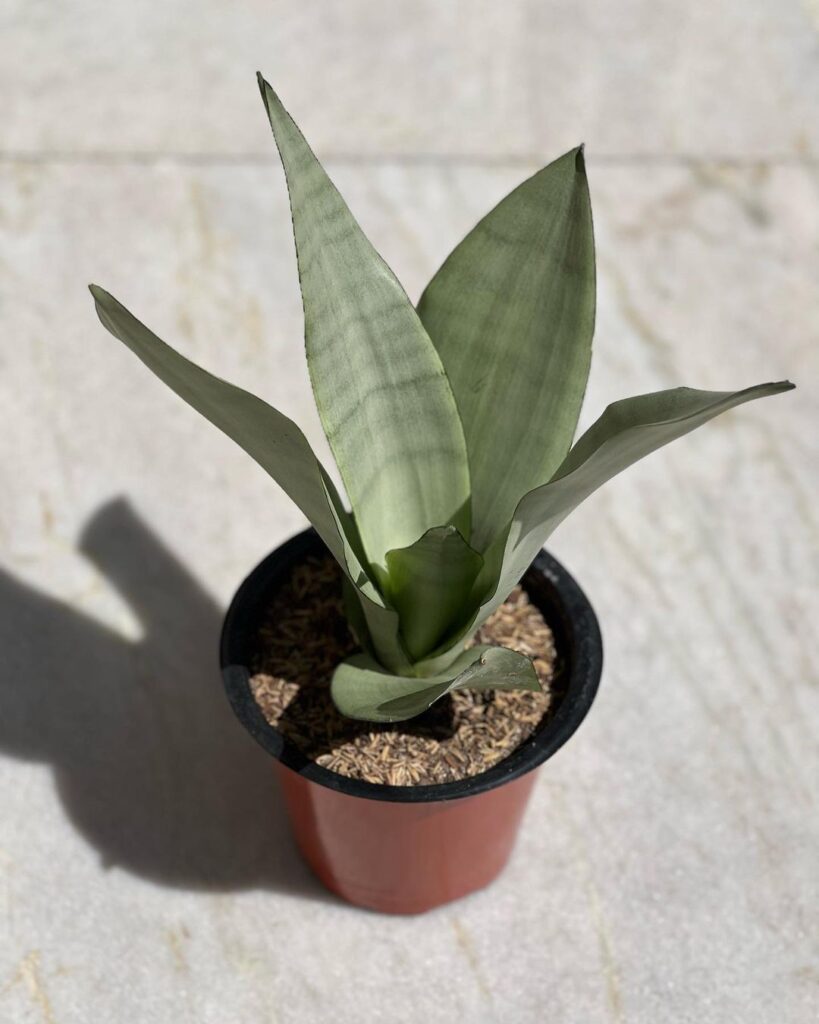
Snake plants are seen as representations of positivism, purity, and good fortune. Although their sharp leaves may seem a little sinister, they are believed to ward off ill luck and evil spirits. In addition, they are highly prized for their sturdy fibers and air-purifying properties.
The snake plant presents some feng shui symbolism. They shield your area from undesirable influences rather than bringing them inside. As a result, they are frequently regarded as lucky and valued plants.
Furthermore, the snake plant is used in ceremonies by some people in West African nations to ward off the evil eye. The capacity of snake plants to stave off attacks is another reason why people value them.
Despite not being native to Asia, humans have been cultivating snake plants there for more than a century. People in China highly value snake plants for their capacity to offer the eight beneficial qualities. These plants are therefore regarded as priceless houseplants and suitable presents.
The snake plant is valued in Korea as well. When someone starts a new company or moves into a new house, potted snake plants are a common present.
Moonshine Snake Plant Symbolism And Meaning
| General Meaning | Positivity, good fortune, purity |
| Symbolism | Good luck, protection from evil, offer 8 beneficial qualities |
Landscaping And Gardening Ideas
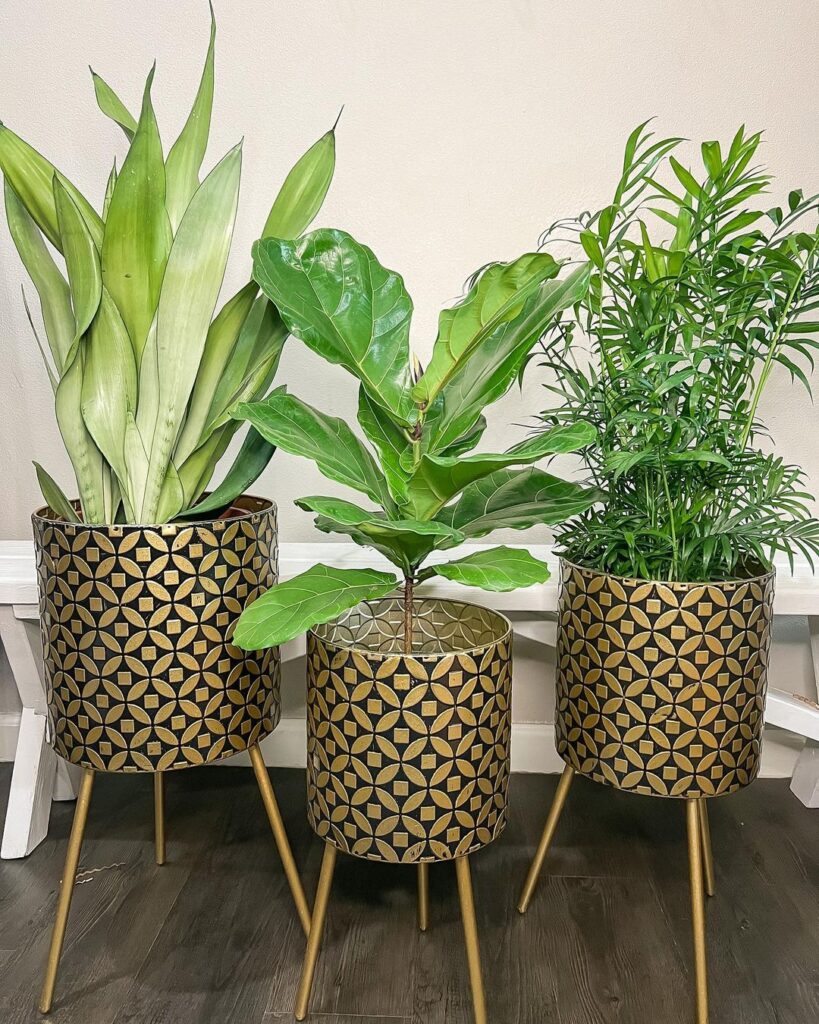
Snake plants provide powerful vertical accents when used alone, flanking an entrance, or in groups with other foliage plants due to their tall, linear appearance. They are excellent plants to relocate throughout the home whenever a dramatic architectural feature is needed because they endure relocation well and are not picky about light needs.
Tabletop plants of the bird’s nest variety, the S. trifasciata ‘Hahnii’ are particularly suitable for low-light locations where few other plants will thrive. They are suitable for terrariums or dish gardens since they are small and slowly develop.
Furthermore, you can also fill bare, uninteresting corners with tall sansevierias positioned on a stylish plant stand. These places are the ideal refuges for these tolerant of shadow plants.
| What To Plant With | Other Aroids, Bird of Paradise, Areca Palms, Fire Spike, Heliconia, Variegated Arboricola, Croton, Chenille Plant, Pentas, Most Tropical Plants |
| What NOT To Plant With | Basically nothing |
Frequently Asked Questions
What Causes the Greening of My Moonshine Snake Plant?
Green leaves indicate too little light is reaching your moonshine snake plant. Your plant will no longer have its unique silvery shine even if it can live in low light.
Change the location of your plant to one that receives more (indirect) sunlight if you notice your leaves becoming green. Even though the lost silver might not come back, doing so will benefit your plant’s health and help it stay from getting any greener.
Are Snake Moonshine Plants Lucky?
Many people believe that keeping a Moonshine Snake Plant in the house will bring good fortune. This is because the plant is so effective in cleaning the air and raising the room’s oxygen level.
According to Feng Shui, the Moonshine Snake Plant’s placement in a space can enhance its lucky traits.
What Is the Growth Rate of My Moonshine Snake Plant?
Moonshine snake plants are slow growing. They seldom reach heights of more than 2-3 feet. More frequently than not, they grow deep roots instead of spreading their leaves.
Good light and watering are essential for growing your moonshine snake plant as tall as possible. Your moonshine snake plant has a lot of incredible characteristics, however, none of these will ever be rapid growth.
Is Moonshine Snake Plant rare?
The Sansevieria trifasciata moonshine is a rare-to-find plant that is native to the Congo and Nigeria. It’s a succulent that may grow quickly both inside and outdoors.
Editor’s Recommendations
Snake Plant (Sansevieria): How To Get Your Plant To Flower and More
Hello, Why Is It Yellow? 5 Reasons Why Your Sansevireia Is Changing Color
Snake Plant Roots: What To Look For In A Healthy Sansevieria Plant







